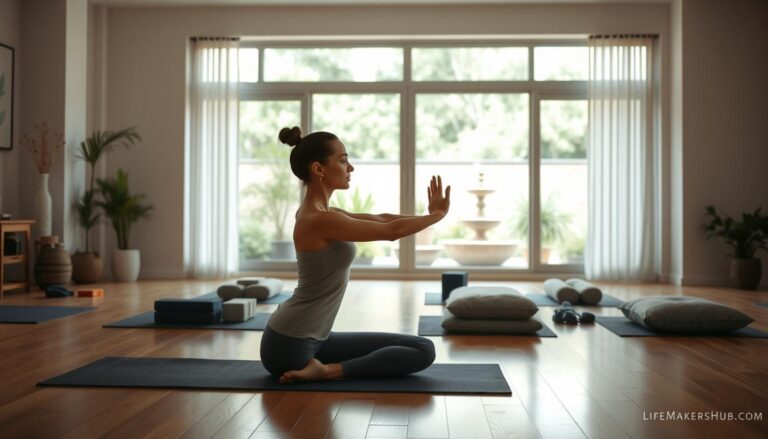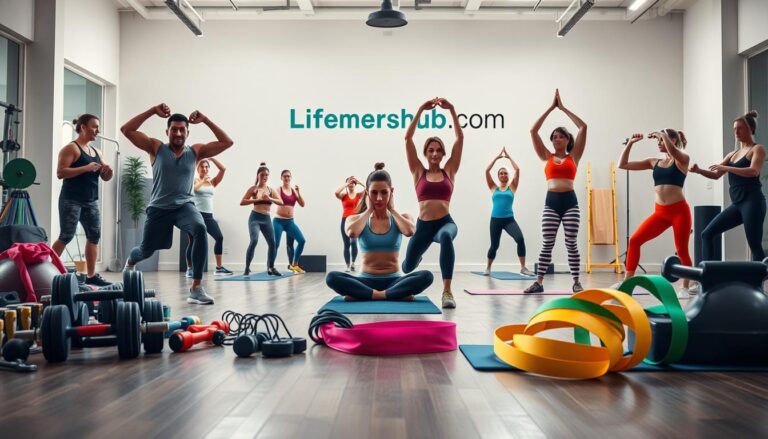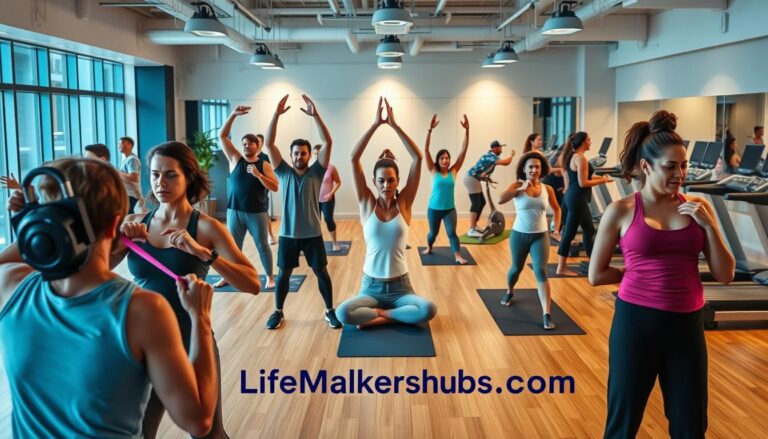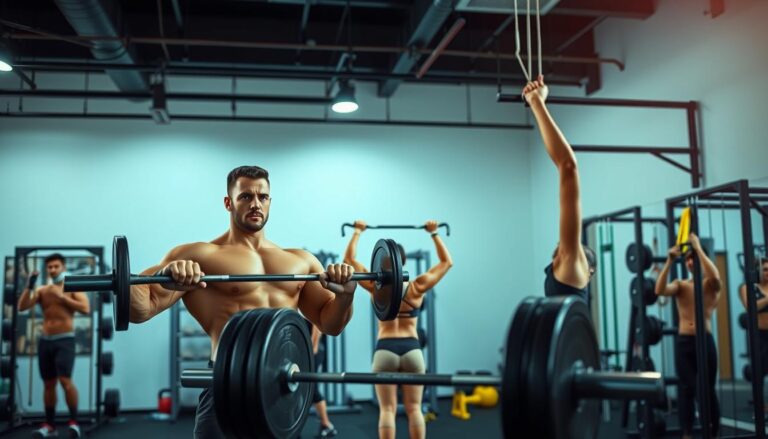LifeMakersHub: Your Guide to Health and Fitness
At LifeMakersHub, we aim to help you improve your health and fitness. Our site gives you practical tips for living healthy. This includes balanced exercise, good nutrition, and mental wellness. We offer science-backed advice for all kinds of lifestyles.
Follow the U.S. Department of Health and Human Services’ advice for heart health. They suggest 150 minutes of aerobic activity a week. Activities like brisk walking or strength training can make you feel better, strengthen muscles, and support your well-being.
We make sure your workouts are safe and effective. We focus on your unique needs.
Key Takeaways
- Adults should aim for at least 150 minutes of moderate aerobic activity weekly to lower disease risks.
- Strength training twice a week boosts muscle strength and improves daily function.
- Even small daily movements count toward better health and longevity.
- Proper hydration and mental health practices are core to healthy living success.
- Listen to your body during exercise to avoid injury and ensure safety.
Understanding the Basics of Health and Fitness
Your journey to better health and fitness starts with clarity. Let’s break down core concepts to build a strong foundation for wellness advice that lasts.
What is Health?
Health isn’t just the absence of disease. The World Health Organization defines it as a state of complete physical, mental, and social well-being. This means eating balanced meals, managing stress, and maintaining meaningful relationships all contribute to your overall wellness.
For instance, the Mayo Clinic emphasizes that even small steps like a 10-minute walk or deep breathing exercises can improve mental and physical health.
What is Fitness?
Fitness focuses on physical capabilities. Key components include:
- Cardiovascular endurance (e.g., brisk walking, cycling)
- Muscular strength (e.g., squats, push-ups)
- Flexibility (e.g., yoga, stretching routines)
- Body composition (healthy fat-to-muscle ratios)
The Department of Health and Human Services recommends 150 minutes of moderate aerobic activity weekly, plus strength training twice a week. Even one set of exercises per muscle group can deliver benefits.
The Connection Between Health and Fitness
“Exercise is medicine.”
Studies show regular physical activity reduces chronic disease risk by improving heart health, blood sugar regulation, and immune function. For example, 150–300 weekly minutes of exercise lower all-cause mortality by 19%, per research on 116,000 adults. Prioritizing fitness strengthens your body’s defenses, directly impacting long-term health outcomes.
Wellness advice often overlooks this synergy. A balanced routine combining nutrition, movement, and rest creates a cycle where improved fitness enhances health, which in turn fuels further physical capability. Start small: a 10-minute walk today builds momentum toward lasting change.
Nutrition: The Foundation of Good Health
Understanding how nutrients fuel your body is key to healthy living. Over 129 million U.S. adults suffer from preventable chronic diseases due to bad diets. This shows that small diet changes can greatly improve health. Let’s look at how to make nutrition tips easy to follow.
Essential Nutrients for a Healthy Diet
Vitamins and minerals like A, C, D, and B12 are crucial. Vitamin D helps absorb calcium, and omega-3s in salmon are good for the heart. Research shows that folic acid in prenatal vitamins can reduce autism risk by 50%.
Understanding Macronutrients and Micronutrients
| Type | Examples | Role |
|---|---|---|
| Macronutrients | Carbs, proteins, fats | Energy and growth |
| Micronutrients | Vitamins, minerals | Immune function, cell repair |
Meal Planning Tips for Busy Lifestyles
- Batch-cook grains and proteins weekly
- Pair veggies with every meal (e.g., spinach in omelets)
- Keep nuts or fruit on hand for snacks
“Small dietary shifts, like swapping soda for water, can lower diabetes risk by 30%.” – AMA Diabetes Prevention Guide
Even 15 minutes of weekend meal prep can make healthy living easier. Focus on whole foods like kale to fight pollution and protect lung health, as NIEHS research suggests.
The Importance of Regular Exercise
Regular physical activity is more than a trend. It’s a way to live longer and feel better. Tailored exercise routines can make your heart stronger, muscles firmer, and mind clearer. Even a short walk each day can help a lot.
“Adults should get at least 150 minutes of moderate-intensity aerobic activity each week.” — CDC
benefits of cardio workouts>
Cardio activities like fast walking or cycling are great for your heart. They can lower heart disease risk by 30% if done regularly. These activities also help your mood and brain work better. Studies show they can cut early death risk by 20%, making them key for any workout plan.
- Brisk walking or jogging (3-5 days/week)
- Swimming or cycling to strengthen heart and lungs
strength training: building muscle and endurance>
As we age, our muscles shrink, but resistance training can stop this. Lifting weights or using bands makes bones stronger, preventing osteoporosis and injuries. Even simple exercises like squats or push-ups can make moving easier. Women won’t get too big; they’ll just get stronger and healthier.
- Squats for lower-body strength
- Resistance band exercises for toning
flexibility and balance: why they matter>
Stiffness and poor balance can lead to falls, especially for older people. Yoga or tai chi can improve flexibility and balance, reducing fall injuries by up to 40%. These activities also help with other exercises and daily activities like bending or climbing stairs.
- Yoga poses to increase flexibility
- Tai chi for balance and coordination
Mixing these elements into a weekly routine is key. Begin with small steps, track your progress, and get help from a trainer. Your body gets better with regular effort, so every workout is a step towards a healthier life.
Setting Realistic Health and Fitness Goals
Only 8% of people hit their New Year’s fitness goals. But, SMART goals can up your success by 30%. For fitness motivation or weight loss strategies, being clear and consistent is crucial. Start with small steps like 15-minute stretches after working out or 3 workouts a week.
SMART Goals Explained
SMART goals make vague ideas into real plans. For instance:
- Specific: “Run a 5K in 12 weeks” instead of “get fit.”
- Measurable: Keep track of weekly run distances or push-ups.
- Achievable: Start with 12 workouts a month, then increase to 16 after 3 months.
- Relevant: Pick activities you like, like cycling or swimming, to stay on track.
- Time-bound: Aim to lose 8 pounds in 10 weeks (1-2 pounds a week).
Tracking Progress Effectively
Don’t just watch the scale. Use other metrics like:
- Pulse rate before and after a 1-mile walk
- Flexibility tests, like seated toe reach
- Weekly step counts (aim for 10,000 steps a day)
If progress slows, adjust your goals. For example, shorten a 5K training plan to 8 weeks if needed.
Staying Motivated on Your Journey
Link new habits to daily routines, like planks after morning coffee. Working with a trainer or buddy can also help—65% see better results. Celebrate small wins, like better flexibility or faster times. For weight loss strategies, get advice from a healthcare provider to set the right calorie and exercise goals. Remember, it’s about being consistent, not perfect. Every small increase in running distance adds up to big success.
The Role of Hydration in Health
Hydration is more than just drinking water—it’s key to health and fitness. Every part of your body needs fluids to work right. Even a little dehydration can slow you down, make you tired, and affect how well you do things.
First, figure out how much water you need. Athletes lose a lot of water when they exercise hard. But even just going about your day, you still need to drink enough.
Healthy living starts with knowing your water needs. Adults should drink 2.5–3 liters a day, depending on how active you are. Check your urine color to see if you’re drinking enough. If it’s light yellow, you’re good. Dark urine means you need to drink more.
For athletes, drinking water with electrolytes is important. Electrolytes are minerals that help your body work right. Sports drinks with 6–8% carbs also help give you energy during long workouts.
- Drink 16–24 ounces of water after you exercise to replace lost fluids.
- Eat foods that help you stay hydrated, like watermelon, cucumber, and soups.
- Drink 24 ounces of fluid 2 hours before you start exercising to do better.
Children and older adults need extra care. Kids lose water fast and show signs of dehydration sooner. Seniors might not feel thirsty as much, which can hurt their kidneys. Electrolyte problems can cause muscle cramps, tiredness, or confusion.
To stay hydrated, it’s simple. Keep a water bottle with you, add some lemon or mint to your water, and watch how much you’re drinking. Drinking enough water helps your joints, skin, and brain work better. Every sip helps you stay healthy.
Mental Wellness and Its Impact on Fitness

Your mental state and physical health are closely linked. Wellness advice often highlights this connection. It shows how stress or anxiety can block fitness goals. Yet, exercise can improve your mood.
Let’s look at how focusing on mental wellness can help your physical health.
“Running 15 minutes daily or walking an hour may cut major depression risk by 26%,” according to Harvard researchers.
Managing stress can help both your mind and body. Here are some effective strategies:
- Mindfulness meditation: Reduces cortisol, the stress hormone.
- Short walks outside: Nature exposure lowers anxiety levels.
- Yoga or Tai Chi: Combines movement with breathing for calmness.
Exercise is a great fitness motivation. Aerobic workouts release endorphins, which help with depression and ADHD. A 2023 study found yoga is better than no treatment for depression.
Even 30 minutes of brisk walking daily can improve focus and sleep. The World Health Organization says depression affects millions. Yet, exercise therapy is a free, accessible solution.
Pair workouts with mindful breathing or music to boost focus. Start with a 10-minute walk or stretching session. Over time, this builds resilience against stress and keeps you on track. Remember, every workout isn’t just for muscles—it’s also mental fuel.
Exploring Different Fitness Trends
Fitness trends keep changing, and finding the right one is key. The American Council on Exercise says personalized plans are a top choice for 2025. Let’s look at the latest trends that are backed by science and loved by many.
The American Council on Exercise identifies inclusivity and tailored workout plans as key trends for 2025.
High-Intensity Interval Training (HIIT)
HIIT is all about quick, intense workouts that boost your metabolism. Even though its popularity has wavered, functional HIIT has seen a 20% rise in 5 years. It combines strength and cardio. Try short sprints followed by rest for a calorie burn.
Yoga and Its Benefits
Yoga does more than just stretch you out. It lowers stress and improves focus. Face yoga has become more popular, with a 43% rise in 5 years. It targets facial muscles. Adding restorative yoga to your routine can help with recovery and mindfulness.
Functional Fitness: What You Need to Know
Functional fitness makes you stronger by mimicking everyday activities. It improves balance and strength. Power training, a part of it, helps older adults stay steady on their feet. Exercises like squats and lunges are key. Searches for “physio exercises” have jumped over 25%, showing its growing appeal.
Health and Fitness Myths Debunked
It’s important to know the truth from false information. Let’s clear up some common myths that might confuse you.
Many people think skipping meals boosts metabolism. But, irregular eating messes with nutrition tips that keep energy and hunger balanced. Fasting trends can actually slow down metabolism over time.
Another myth is that carbs are bad for everyone. But, complex carbs like whole grains are good for workouts and recovery when eaten with protein and fiber. Fad diets that promise quick results often fail in the long run. Long-term weight loss strategies are better than quick fixes.
Body shape isn’t set in stone. Muscle and fat can’t change into each other. Muscle gain needs consistent strength training, while losing fat requires fewer calories.
Women naturally have less testosterone than men, making it hard to build bulk without steroids. While genetics play a role in body type, exercise and nutrition tips can still improve health. Focus on making progress, not being perfect.
Creating a Balanced Weekly Fitness Routine
A good fitness routine has variety, rest, and support from friends. Start by planning workout plans that include cardio, strength, and flexibility. The CDC suggests 150 minutes of moderate activity each week and two days of muscle-strengthening exercises.
Designing a Diverse Workout Plan
Effective exercise routines need a clear plan. Here’s a sample plan:
- Day 1: 30-minute brisk walk + 15-minute strength training (upper body)
- Day 2: 20-minute HIIT (based on Journal of Physiology research) + stretching
- Day 3: Yoga or swimming for full-body engagement
- Day 4: Lower body strength (squats, lunges) with 3 sets of 10 reps
- Day 5: Outdoor activity like cycling (University of Glasgow study linked biking to reduced disease risk)
Importance of Rest Days
Muscles need time to recover. Include two rest days each week. Active recovery options include gentle walks, yoga, or swimming. Wait 48 hours before training the same muscles again to avoid injury.
Sleep and nutrition help muscles repair. Make sure to eat enough protein after working out.
Incorporating Family and Friends
Make workouts a fun group activity. Try group activities like:
- Biking trips (try local trails)
- Home-based HIIT circuits
- Weekly family hikes
Adjust exercises for everyone’s fitness level. For example, offer high-impact moves and easier versions for beginners.
The Role of Technology in Health and Fitness
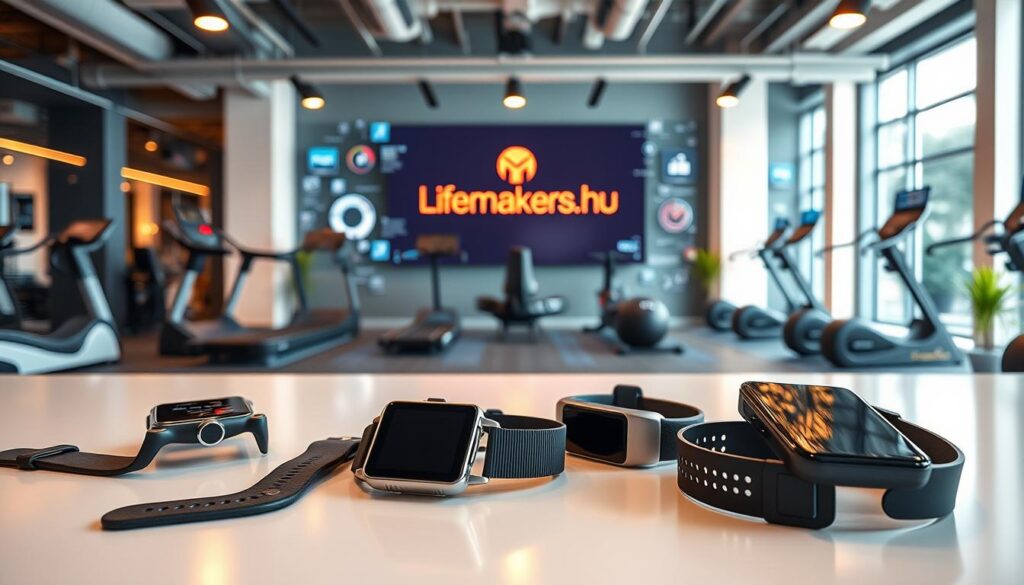
Technology changes how we think about fitness motivation and healthy living. Apps and wearables can help us reach our goals. But, we must use them wisely to stay focused on our well-being.
Top Fitness Apps You Should Try
Apps like MyFitnessPal and Strava help make goals a reality. Look for features that fit your needs:
- Nutrition tracking for mindful eating
- Custom workout plans
- Progress visualizations
- Privacy settings for data security
A study shows 50% of smartphone users have fitness apps. But, 70% stop using them soon. Pick apps that fit your lifestyle, not just the latest trends.
Wearables and Health Tracking Devices
Devices like Apple Watch or Fitbit offer real-time feedback. But, 23% of adults don’t meet basic activity levels. Use these tools to track progress, not just numbers.
A study found users aiming for 10,000 steps increased their activity by 108% with rewards. Use technology to guide you, not control you.
Engaging with Online Fitness Communities
Join groups on Instagram or Reddit for support. One study found social support boosts activity in inactive adults. But, don’t compare yourself to others’ achievements.
Platforms like Nike Training Club offer workouts and support. They help keep you motivated and engaged in healthy living.
Technology isn’t a magic fix. Use apps for meal planning, wearables for tracking, and communities for support. Balance tech with real-life actions, and let tools help you achieve your goals.
Evaluating Your Health and Fitness Journey
“Regular check-ins with your goals ensure your fitness journey stays aligned with your true needs.” – Health Professionals
Tracking your progress keeps you on track. Here’s how to check your journey and keep moving.
When to Seek Professional Help
Experts can help when you hit a wall. Look for help when:
- You hit a plateau despite hard work
- Unexplained pain or tiredness interferes with daily life
- You’re unsure about safe weight loss for your body
Adjusting Your Goals as You Progress
Life changes mean updating your goals. Follow these steps:
- Look at your logs to spot trends. Track things like strength gains or sleep.
- Make new goals using SMART criteria. For example, “Lose 8 pounds in 10 weeks with 150 minutes of cardio and 3 strength training days.”
- Change your weight loss plans every 3 months to fit your new lifestyle and health.
Celebrating Achievements and Milestones
Recognizing your wins boosts motivation. Try these ideas:
| Milestone | Celebration Idea | Why It Works |
|---|---|---|
| 5% body fat reduction | Book a fitness photoshoot | Visual proof of transformation |
| Completed 100 workout days | Plan a weekend hike | Encourages active celebration |
| Finished a fitness course | Donate to a health charity | Turns achievement into giving back |
Small rewards keep you motivated. Regular checks turn challenges into chances for growth.
Building a Supportive Health and Fitness Community
Creating lasting fitness motivation and healthy living habits often needs more than just willpower. A strong support network can help turn short-term goals into lasting changes. When 50% of gym members quit within six months, finding a community is key to staying on track.
Communities offer accountability, shared goals, and encouragement. They help you push through tough times. Here’s how to build the right support system.
Finding a Workout Buddy
Working out with a buddy adds a layer of accountability. Look for someone with similar schedules and goals. Agree to regular check-ins and celebrate your successes together.
Research shows that personal communication, like gym staff knowing your name, builds loyalty. Even casual chats with gym staff can make workouts feel like a shared journey.
Joining Local Fitness Groups
Local groups like yoga studios or running clubs offer structured support. Platforms like Fitness On Demand’s 1,200+ classes provide flexibility. In-person events help build friendships.
These groups expose you to new activities and people. Studies show that social interactions, from small-group workouts to challenges, help you stay committed. They foster a sense of belonging.
Leveraging Social Media for Encouragement
Social media boosts fitness motivation by sharing progress and challenges. Follow positive accounts and join forums. Digital rewards, like free classes for referrals, motivate you to keep going.
But remember, social media can also show unrealistic expectations. Use it to connect with others who share your goals.
At LifeMakersHub, we’re part of your community. Check out our resources for local groups, tracking progress, and joining challenges. A supportive network is the key to lasting healthy living. Start building your circle today.
FAQ
What types of exercise routines are recommended for beginners?
How can I incorporate nutrition tips into my busy schedule?
What weight loss strategies are most effective for long-term success?
How often should I change my workout plans for optimal results?
What are some good sources of hydration besides water?
How can I stay motivated in my health and fitness journey?
What is the significance of the mind-body connection in fitness?
Are there any particular fitness trends that I should be cautious about?
What are the most common misconceptions about dieting?
How can family and friends help with my fitness goals?
Source Links
- 7 great reasons why exercise matters
- Three Types of Exercise Can Improve Your Health and Physical Ability
- Fitness Fitness basics
- Fitness: What It Is, Health Benefits, and Getting Started
- 5 steps to start a fitness program
- Health benefits of eating well
- Nutrition, Health, and Your Environment
- 6 things doctors wish patients knew about better nutrition
- Benefits of Physical Activity
- Benefits of Exercise: MedlinePlus
- 10 Realistic Fitness Goals, Recommended by Personal Trainers
- Set Your Fitness Goals
- Setting Realistic Health and Fitness Goals for the New Year – True Health and Performance
- Sports and Hydration for Athletes: Q&A with a Dietitian
- The Role of Hydration in Your Health and Wellness
- Water, Hydration and Health – PMC
- How Does Exercise Improve Mental Health?
- Role of Physical Activity on Mental Health and Well-Being: A Review
- Exercise is Key in Mental Health & Well-being
- 9 Top Fitness Industry Trends (2024 & 2025)
- 10 Fitness Trends to Look Forward to in 2025
- NimbleRx I Exploring Fitness Trends for a Healthier You
- 7 exercise myths debunked
- Health and fitness myths busted
- 6 exercise myths debunked
- Try This 7-Day Workout Routine for Your Exercise Goals
- Here’s What a Perfectly Balanced Weekly Workout Schedule Looks Like
- How to build a balanced fitness routine | Adventist Health
- What is the relationship between technology and health?
- Behavior Change with Fitness Technology in Sedentary Adults: A Review of the Evidence for Increasing Physical Activity
- Association between fitness technology use and physical activity mediated by communication behaviors on social media
- Reflect, Reset, and Recharge: Evaluating Your Fitness Journey Through 2024 –
- Exercise 101: Begin Your Health and Fitness Journey Here
- Feeling “Blah?” How to Enjoy Your Fitness Routine Again – Hancock Health
- How to Build a Fitness Community – The 6 Essential Steps – Boutique Fitness and Gym Management Software – Glofox
- How To Build a Stronger Gym Community | Fitness…
- Lost All Motivation to Exercise? Try These Simple Strategies to Kickstart Your Workout Momentum


